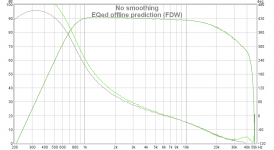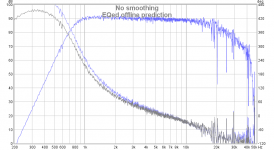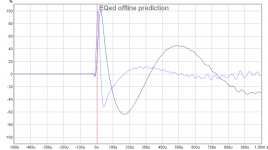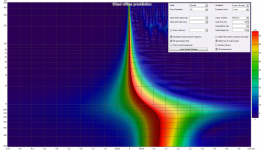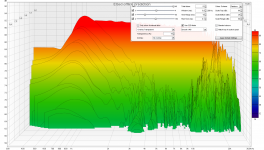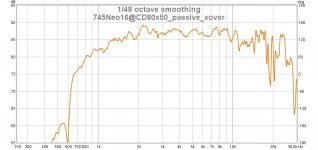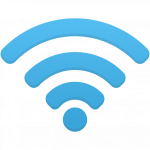After some speculation and above looks maybe too good to be true for acoustic domain especially if they comp filter reflections sits there, therefor find first below where we can see raw FDW filtered response that was used above times reverse correction curve, second is same raw but non FDW filtered and the next three are result when this one is times reverse correction curve, and overall think correction result is still pretty good.
Attachments
It looks being in yours too just harder to see because of crude time scale, below should help with a zero time line edited white then follow performance of black dotted peak energy time which very weird show frq 4kHz and up will happen before real time, the one at right better follow book for minimum phase domain.
It looks like the actual start of the IR is the peak before the one that hits 100%. REW aligns the highest peak and takes that as t=0.
It does, yes. Zeroing it out doesn't seem to help much. I'm used to HOLMImulse where the options to choose impulse start times are many and varied.
On the IR tab, under controls you can offset the IR so the t=0 starts at the other peak. [t=0 offset (ms)]
If you are really interested you can download the Beyma TD385 datasheet and look there.
Is this your only criteria to assess a horn / driver combination?
Is this your only criteria to assess a horn / driver combination?
Yea, that's pretty much the case. I will sometimes look at the impulse response and the impedance for delayed reflections and the like, but polar response control is still paramount.
It's not all about directivity per se. There is a plethora of good information on horn/driver problems revealed in the polars.
It's not all about directivity per se. There is a plethora of good information on horn/driver problems revealed in the polars.
Can you please, briefly touch on the useful points to gather from the polars? Other than directivity -- for a newbie...
If radiation is like a wifi symbol the waveguide will do its job, which (besides directivity control) is to respect the source (keeping it the true source). If the horn isn't the right shape, if the driver wavefront isn't right or matched to the horn, if sound diffracts in a bad way then energy will be spatially lost with possibly complex undesirable characteristics.
Attachments
This is really funny, you give an WiFi symbol as justification for your post 
It should not be too hard to give us real examples and measurements here, good and bad looking driver/horn polars with an detailed explaination why something is good and why not on paper and why something is good or bad with respect to the last instance: our ear/brain system?

It should not be too hard to give us real examples and measurements here, good and bad looking driver/horn polars with an detailed explaination why something is good and why not on paper and why something is good or bad with respect to the last instance: our ear/brain system?
I'm glad you like my humour. This information is interspersed in this and other key threads, such as the Geddes on waveguides thread and is quite involved. But if you want an example, OK..
A waveguide wall is like a mirror. If the wavefront travelling along it is normal to it then it effectively holds it the same as how what would be there in an equivalent full space radiation. If it is not then the reflection will deviate and have an effective source that is in a different location in space, such as direction and timing, and could be heard as such and could also continue to become a room wall reflection. Once the energy goes wayward it is no simple task to stop it so it needs to be kept right from the start, and typically for as long as practical.
Respecting the source as I alluded to above, is in my opinion key to getting the most out of a waveguide system. Using the oblate spheroidal shape is the key to doing this when beginning with a typical compression driver with a round planar wavefront.
A waveguide wall is like a mirror. If the wavefront travelling along it is normal to it then it effectively holds it the same as how what would be there in an equivalent full space radiation. If it is not then the reflection will deviate and have an effective source that is in a different location in space, such as direction and timing, and could be heard as such and could also continue to become a room wall reflection. Once the energy goes wayward it is no simple task to stop it so it needs to be kept right from the start, and typically for as long as practical.
Respecting the source as I alluded to above, is in my opinion key to getting the most out of a waveguide system. Using the oblate spheroidal shape is the key to doing this when beginning with a typical compression driver with a round planar wavefront.
All the O.S waveguides I've seen in person or in print are just a shallow conical horn with better throat. In this case a short curved throat with that particular profile.Using the oblate spheroidal shape is the key to doing this when beginning with a typical compression driver with a round planar wavefront.
The easing of the flair at the throat does seem an improvement over abruptness of pure conical.
What I am currently wondering about is the discussion culture.
We were in an brilliant exchange of different experiences/measurements/analysis of impulse responses, mainly at HF where any horn is probably more or less of minor relevance. We were not at the point what is the best horn/waveguide.
I would assume that many of us would greatly appreciate if the supporters of OS waveguides deliver comparable measurements or maybe better drivers.
POOH crititzied the Radians but he delivered measurements we were able to discuss about and compare them. I really appreciate his kind of discussion.
We were in an brilliant exchange of different experiences/measurements/analysis of impulse responses, mainly at HF where any horn is probably more or less of minor relevance. We were not at the point what is the best horn/waveguide.
I would assume that many of us would greatly appreciate if the supporters of OS waveguides deliver comparable measurements or maybe better drivers.
POOH crititzied the Radians but he delivered measurements we were able to discuss about and compare them. I really appreciate his kind of discussion.
Almost fifteen thousand post in and we're not at that point? Will we ever be?We were not at the point what is the best horn/waveguide.

Almost fifteen thousand post in and we're not at that point? Will we ever be?
😀
I'm glad you like my humour. This information is interspersed in this and other key threads, such as the Geddes on waveguides thread and is quite involved. But if you want an example, OK..
A waveguide wall is like a mirror. If the wavefront travelling along it is normal to it then it effectively holds it the same as how what would be there in an equivalent full space radiation. If it is not then the reflection will deviate and have an effective source that is in a different location in space, such as direction and timing, and could be heard as such and could also continue to become a room wall reflection. Once the energy goes wayward it is no simple task to stop it so it needs to be kept right from the start, and typically for as long as practical.
Respecting the source as I alluded to above, is in my opinion key to getting the most out of a waveguide system. Using the oblate spheroidal shape is the key to doing this when beginning with a typical compression driver with a round planar wavefront.
Hi,
I would suggest to do all measurements about 1m or 2m from the horn mouth, so all sound waves interactions would be visible on the measurements. It is very, very rare circumstances where a listener is several centimeters from the horn mouth.
regards
ivica
- Home
- Loudspeakers
- Multi-Way
- Beyond the Ariel
